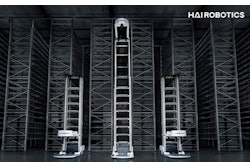
End-of-line (EoL) packaging is composed of the last operations performed before product is shipped. In the race for profits, the shipping docks are the in-house finish line. It’s better to have arrived via a timed, steady pace, than to have arrived slowed or stopped. By that analogy, EoL packaging needs to be smoothly integrated into a facility’s overall packaging-line operations. Such integration is a cost-effective way to increase productivity and efficiency.
Regardless of its size, any company can be faced with decisions about automating EoL packaging. That’s because it’s not just about the present amount of automation, but whether it is the most suitable for that company. The recognition that automation bestows benefits is an easy one, but it does not preclude having to grapple with a host of related considerations. What level of automation is warranted, for example, full or semi-? Can a present machine or station be retrofitted? Short of a complete EoL overhaul, how are individual operations to be prioritized in terms of benefits derived from their automation?
There are unargued benefits of automation, although their importance is company-specific and sometimes industry-specific. Automation, for example, always involves a machine vs. manpower dynamic. Machines perform with a combination of speed, accuracy, consistency, and tirelessness that manual labor is unable to match. But manpower seldom, if ever, is completely eliminated. It can serve us well, then, to think in terms of a machine-manpower interface.
In further proof that automation is not the unwavering nemesis of manpower, benefits also accrue to the labor force. Workers are freed from tedious tasks and thereby are assignable to more rewarding utilization of their time and skills. Automation reduces workers’ accidents and injuries, too. One example, serving for many, involves manual palletizing (positioning and loading). Pallets themselves typically weigh between 35 and 50 lb., not to mention the weights of what goes onto them. Together, that’s enough weight to induce chronic skeletomuscular ailments.
Another benefit of automation is the reduction in damaged goods. Any member of the supply chain—not only the retailer—can be a dissatisfied victim. All members of a supply chain know that there are expenses associated with the receipt, handling, separation, and accounting of damaged goods. Automation can foster greater goodwill among members, which is a type of competitive advantage.
Although it’s necessary to enumerate the benefits of automation, it’s not sufficient. The benefits need to be quantified in dollars and cents. Benefits need to be quantified as to what’s being lost by not having optimal automation, and conversely, what is to be gained by achieving optimal automation. It’s a wave-tossed sea but it has to be navigated, otherwise reaching the proper port of automation becomes a rudderless voyage. Packaging professionals must be aboard, for self-evident reasons. But so too must other crewmembers (don’t forget, packaging is interdisciplinary in nature). As for those others, the following order of mention is not indicative of a ranking of importance.
























